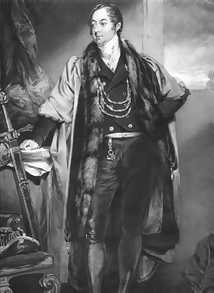Lawrence Dundas, 1st Earl of Zetland


Lawrence Dundas, 1st Earl of Zetland (10 April 1766 – 19 February 1839) was a British politician and peer who sat in the House of Commons from 1790 to 1820 when he was raised to the peerage of the United Kingdom.
Early life
[edit]Dundas was the son of Thomas Dundas, 1st Baron Dundas and was born in Westminster on 10 April 1766. He was educated at Harrow and was admitted at Trinity College, Cambridge.[1] He married Harriot Hale, one of the twenty-one children of General John Hale and his wife Mary Chaloner, by whom he had three sons and four daughters.[2]
Military career
[edit]In 1789 Dundas was commissioned as a Captain in the disembodied North York Militia, of which his father was Lieutenant-Colonel. The regiment was embodied for full-time service on the outbreak of the French Revolutionary War, and Dundas was promoted to Major in 1795. In the frequent absences of the Colonel, Earl Fauconberg, and his father on parliamentary business, Dundas was often left in command of the regiment on its coast defence duties. When Fauconberg resigned the command on grounds of ill-health in 1797 Lord Dundas was appointed colonel and Major Lawrence Dundas was promoted to Lieutenant-Colonel. The regiment was disembodied after the Treaty of Amiens in 1802, but was re-embodied in 1803 when the peace broke down. However, Dundas resigned to become Lt-Col Commandant of the new Cleveland Volunteers on 24 October 1803.[3][4] After an initial burst of enthusiasm, the volunteers declined and were replaced in 1808 by units of Local Militia raised under compulsory service. Dundas was commissioned as Lt-Col Commandant of the 3rd North York Local Militia on 24 September 1808. The Local Militia was disbanded in 1816.[5]
Political career
[edit]Dundas was elected Whig Member of Parliament for Richmond, North Yorkshire in 1790. Twelve years later he exchanged this seat for that of York, and in 1808 returned to Westminster as representative for his old Richmond seat. In 1811 he was again elected MP for York, and became Lord Mayor of the city that same year, having been an alderman since 1808. He was Lord Mayor a second time in 1821.[2]
In 1820 Dundas succeeded his father as second Baron Dundas and as a baronet. He was appointed Lord Lieutenant of Orkney and Shetland in 1831, and in 1838, on the occasion of the coronation of Queen Victoria, he was created Earl of Zetland (i.e. Shetland) for having provided financial assistance to the new Queen's parents, the Duke & Duchess of Kent, in the years preceding her accession.[2]
Slave holder
[edit]According to the Legacies of British Slave-Ownership at the University College London, Zetland was awarded compensation in the aftermath of the Slavery Abolition Act 1833 with the Slave Compensation Act 1837. [6]
Zetland was associated with "T71/880 Grenada claim no. 604 (Dougalston Estate)" and "T71/881 Dominica claim no. 576A & B (Castle Bruce)", he owned 351 slaves in Grenada and Dominica and received a £8,135 payment at the time (worth £975,176 in 2024[7]).[8]
Later life and legacy
[edit]Dundas's wife died in 1834. He died suddenly on 19 February 1839 at his home of Aske Hall, Yorkshire. He was succeeded by his eldest son Thomas Dundas, 2nd Earl of Zetland.[2]
He is buried in the family vault at Trinity Church in central Falkirk.
References
[edit]- ^ "Dundas, Lawrence (DNDS784L)". A Cambridge Alumni Database. University of Cambridge.
- ^ a b c d "DUNDAS, Hon. Lawrence (1766-1839), of Marske, nr. Redcar, Yorks". History of Parliament Online. Retrieved 9 October 2017.
- ^ Major Robert Bell Turton, The History of the North York Militia, now known as the Fourth Battalion Alexandra Princess of Wales's Own (Yorkshire Regiment), Leeds: Whitehead, 1907/Stockton-on-Tees: Patrick & Shotton, 1973, ISBN 0-903169-07-X, pp. 70–1, 85–6, Appendix S.
- ^ War Office, A List of the Officers of the Militia, the Gentlemen & Yeomanry Cavalry, and Volunteer Infantry of the United Kingdom, 11th Edn, London: War Office, 14 October 1805/Uckfield: Naval and Military Press, 2005, ISBN 978-1-84574-207-2.
- ^ 'Local Militia – North Yorkshire' at Richard A. Warren, This Re-illuminated School of Mars: Auxiliary forces and other aspects of Albion under Arms in the Great War against France.
- ^ "Lawrence Dundas, 1st Earl of Zetland". University College London. Retrieved 20 March 2019.
- ^ UK Retail Price Index inflation figures are based on data from Clark, Gregory (2017). "The Annual RPI and Average Earnings for Britain, 1209 to Present (New Series)". MeasuringWorth. Retrieved 7 May 2024.
- ^ "Lawrence Dundas, 1st Earl of Zetland". University College London. Retrieved 15 September 2021.
External links
[edit]- 1766 births
- 1839 deaths
- People from Westminster
- Nobility from Falkirk (council area)
- People educated at Harrow School
- Alumni of Trinity College, Cambridge
- Earls in the Peerage of the United Kingdom
- People associated with Shetland
- Anglo-Scots
- Councillors in North Yorkshire
- North York Militia officers
- Members of the Parliament of Great Britain for English constituencies
- British MPs 1790–1796
- British MPs 1796–1800
- Members of the Parliament of the United Kingdom for English constituencies
- UK MPs 1801–1802
- UK MPs 1802–1806
- UK MPs 1806–1807
- UK MPs 1807–1812
- UK MPs 1812–1818
- UK MPs 1818–1820
- UK MPs who inherited peerages
- UK MPs who were granted peerages
- Lord lieutenants of Orkney and Shetland
- Lord mayors of York
- Clan Dundas
- Recipients of payments from the Slavery Abolition Act 1833
- British slave owners
- Peers of the United Kingdom created by Queen Victoria
